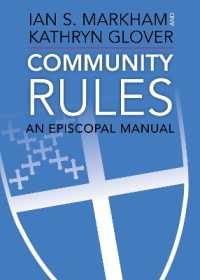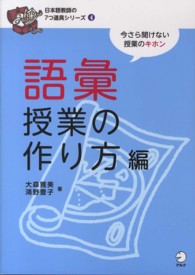- ホーム
- > 洋書
- > 英文書
- > Science / Mathematics
Description
(Text)
Surviving the demise of his humoral pathology and anatomy, Galen s works on simple and compound remedies (the so-called galenicals ) formed the backbone of Western pharmacology up until the Industrial Revolution. Over its long and multicultural tradition spanning the Roman Empire and Byzantium, through Islamicate societies, India, and China, to the New World and even Japan Galenic pharmacopoeia evolved to incorporate new remedies, foods, philosophical rationales, and modes of preparation, including chemical ones. Despite its endurance, a systematic exploration of the use of galenicals beyond the Renaissance remains overdue.
Addressing this gap, the contributions in this volume bring together leading scholars who illuminate how this medical tradition unfolded in the early modern period and its underlying dynamics, often drawing on new or overlooked archival material. Challenging the prevailing narrative of decline, they examine how pharmacological knowledge was transmitted across languages and medical traditions. Each contribution highlights an aspect of the various conceptual adaptations this process entailed, including textual transmission, debates over the structure of matter, occult qualities, dosage quantification, apothecary regulations, patient treatment, and the integration of galenicals into household medicine. Special attention is also given to the commodification of materia medica in Atlantic trade, while a comprehensive introduction contextualises the main themes of Galen s post-Renaissance legacy and explores the reasons for its enduring vitality.
Chapter 13 is available open access under a Creative Commons Attribution-NonCommercial-NoDerivs 4.0 International License via link.springer.com.
(Table of content)
Chapter 1: Beyond Demise: The Long Afterlife of Galenic Pharmacopoeia; Fabrizio Bigotti and John Wilkins.- Part I. Traditions.- Chapter 2: Galen, De Simplicibus from Byzantium to the Early-Modern World: A Difficult Assimilation?; Alain Touwaide.- Chapter 3: Copyists and Translators of Galen s De antidotis in the Renaissance: Georgios Alexandrou, Petros Hypselas, Iosephus Struthius, and Michelangelo Angelico; Simone Mucci.- Chapter 4: Pharmacological Tables of Galen s De Simplicibus in Leonhart Fuchs and Janus Cornarius; Maximilian Haars.- Chapter 5: A Matter of Taste: Lorenz Gryll and his De Sapore (1566); Vivian Nutton.- Part II. Theories.- Chapter 6: Determining Dosage: The Rationalisation of Therapy in the Long Renaissance; Fabrizio Bigotti.- Chapter 7: Sympathy, Antipathy, and the Nature of Occult Qualities in Galen and Jean Fernel; Brooke Holmes.- Chapter 8: Drug Absorption and Food Digestion in Late Renaissance Medicine: The Galenic Interpretation of Jean Fernel (1567);Elisabeth Moreau.- Chapter 9: Reductionism and Emergentism in Sixteenth-Century Theories of Antidotes: The Cases of Thomas Erastus and Girolamo Mercuriale; Andreas Blank.- Part III. Trades and Transformations.- Chapter 10: The Role of Lignum Vitae (Guaiacum sanctum L) in the Context of Majorcan Reception of Galen s pharmacology during the Fifteenth to Sixteenth Centuries; Pablo José Alcover Cateura.- Chapter 11: The Columbian Exchange and Galenic Pharmacology: Galenic Materia Medica in the Viceroyalty of New Spain; Paula de Vos.- Chapter 12: Between Tradition and Transformation: Galenic Simples and Paracelsian Iatrochemistry in Early Modern English Domestic Medicine; Zoe Screti.- Chapter 13: The Case of Corallium Rubrum: Controversies and Consistencies in the Interpretation of a Galenic Simple in Early Modern England; Francesca Elizabeth Richards.
(Author portrait)
Fabrizio Bigotti is the Director of the Centre for the Study of Medicine and the Body in the Renaissance (CSMBR) in Italy, Guest Lecturer at the Julius Maximilians Universität Würzburg, Affiliated Scholar at the University of Cambridge, and Honorary Fellow at the University of Exeter, UK.
John Wilkins is Professor Emeritus of Greek Culture at the University of Exeter, in the UK. He works on the history of drama, food, and medicine, with an emphasis in recent years on nutrition and pharmacology in the ancient world.








